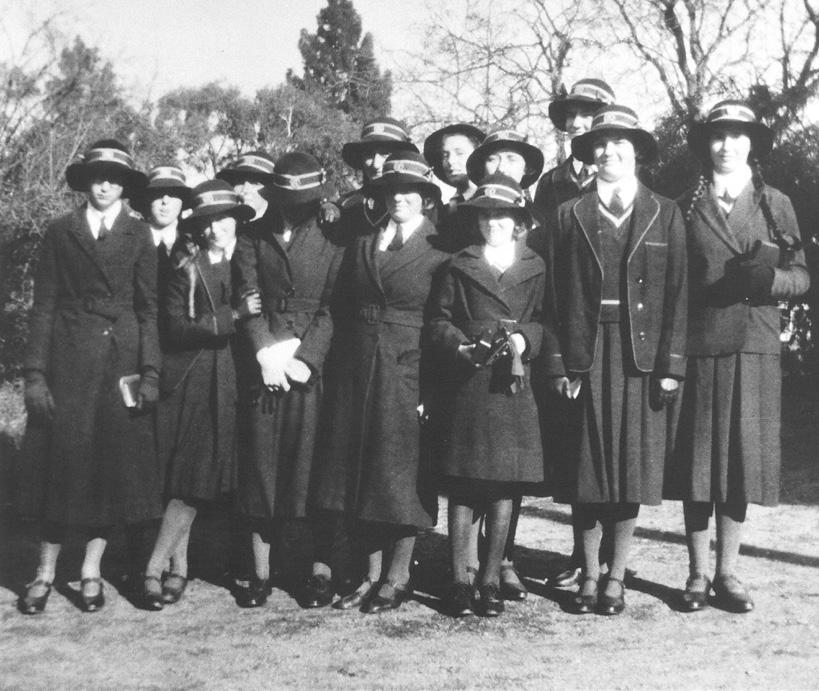
5 minute read
Stories from the Archives
1 2

Advertisement
BOARDING AT WILDERNESS
The chronicle of Boarding at Wilderness School has undergone a long and convolved evolution as the School has progressed and advanced over its 137-year history. Only three months after moving from the former Northcote Terrace site to its present location in 1893, Wilderness took in its first boarder, Amy Bailey, from Two Wells. She was later joined by a second boarder, Gertrude Hailey, and then various others. By 1906, the Browns had 15 boarders, some of whom would go home for the weekends. Boarders were treated more like family than paying pupils. Mr Brown would accompany the country boarders to and from the Adelaide Railway Station and Mrs Brown looked after their meals, clothes, books and health.
The Browns’ house had a simple and homely atmosphere with cheerful family life at its centre.
In the early days, boarders slept in a room above the Drawing Room and on the enclosed verandah. Miss Mamie occupied a top bunk at the end of the dormitory in the downstairs sleep-out and would wake the girls at 6:00am saying “hairbrushes girls”. For ten minutes the boarders had to brush their hair before dressing, having breakfast and going outside to practice sport before they commenced their lessons. Boarders spent Saturday afternoons going on outings to places such as Grange Beach, the Botanic Gardens, Waterfall Gully or concerts and plays. They had one free weekend a month and might organise a social and invite some of their day-girl friends. Generally, the meal on a Saturday was not memorable unless a boarder had a birthday, which meant she was allowed to choose a ‘party’ item – the choice was either banana custard or jelly! However, on Sunday evening a treat was always provided. Miss Margaret regularly took the tram into the city on Friday afternoons and purchased rich madeira and coffee cake for the boarders’ Sunday dinner. Each Sunday the boarders would walk to either St Andrew’s Church in Walkerville or Brougham Place Congregational Church in North Adelaide under the supervision of one of the Misses Brown. Nightly prayers were said after the evening meal and a hymn was sung, accompanied by the piano. Sunday afternoon, being a time for an enforced rest, was devoted to learning a psalm. There was no regulation for the style of the frock worn to church, but it had to be ‘seemly’. One boarder’s mother ordered a new Sunday frock for her daughter but when the dressmaker delivered it, it was decided the neckline was far too low, so Miss Mamie produced a ‘high front’ for the girl to put under the neck of her dress. Apparently, she was much miffed! Every week, Miss Annie would administer the boarders with a dose of Epsom salts or castor oil floating in orange juice and would ensure that each girl ate her entire meal. The girls became remarkably skilled at disposing of unwanted food not to their liking onto the next girl’s plate, into an envelope or pocket, or under the bowl of sugar on the table. When times were frugal, the girls were only allowed either butter or jam on their slice of bread but not both. Boarders have told us in their later years that they buttered one side of the bread and, when unobserved, flipped over the slice to put jam on the other side!

1. No 47 Matriculation Boarders’ Residence. 2. Boarders ready for church, 1936. 3. Boarders’ Fee Schedule, 1948. 4. Boarders’ requirements, 1945.

By 1928, 28 boarders were living with the Brown family. Ablution blocks were unknown in those days and only one bathroom upstairs and one downstairs meant boarders’ bathing was strictly limited. The bathrooms did not have hot water and comprised washstands with basins and jugs. Bathing facilities were basically a wash with a cloth. If boarders wished to wash their hair, they used a basin outside the back door and threw the contents of the jug over themselves to rinse off. The Misses Brown handed the School over to a Council of Governors in 1948 and the number of students was reduced in order to convert a small upstairs dormitory into an ablution block with showers, lavatories and basins. After the Browns handed over the School, Miss Mamie continued as Headmistress for several years before retiring. As late as 1956, she was still completely responsible for the boarders. She distributed pocket money and managed kitchen staff, laundry, and school cleaning. This indomitable 78-year-old was matron and housekeeper rolled into one. Council appointed a succession of house matrons of varying ages and calibre. Still, the Browns were accustomed to managing the girls and the matrons found it hard to submit to their intrusion.

In 1960, 29 Northcote Terrace was purchased and arrangements for boarders changed with the opening of ‘Mary Home House’ in 1961. Senior boarders and the boarders’ kitchen and dining room were transferred there, relieving Miss Mamie of her kitchen duties. The new matron appointed to Mary Home House remained in charge for 10 years. By 1963 there were 34 boarders, divided between Mary Home House and School House. In 1966, the house adjacent to Mary Home House was purchased and the two houses were linked. A wing was added to create a courtyard between them. This enabled boarding numbers to rise to 66, all of them housed within the one complex. In 1970, 47 Northcote Terrace was purchased (now the Art Centre), allowing matriculation boarders and a house mistress to relocate. The old two-storey Tudor-style house contained two study rooms, a kitchen, a music room and the resident house mistress’ bedroom. Upstairs were dormitories and two bathrooms. The girls were encouraged to be independent and responsible and on weekends they cooked their own meals. Few activities were compulsory. In 1989, another house south of Mary Home House was purchased, and 47 Northcote Terrace became the Art Centre, with all boarders now located in one area. In 2008, the Boarding House kitchen and laundry were removed, and the Wilderness Café and boarders’ dining room were added.
3 4

Rebecca Foster Head of Advancement









